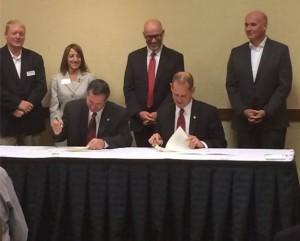Port, North Dakota Agriculture partner to turn empty train cars into opportunity, economic growth

Port CEO Todd Coleman, right, and North Dakota Department of Agriculture Commissioner Doug Goehring sign the MOU on Aug. 27 in Fargo, ND (photo credit: NDDA)
Building on the Port of Vancouver USA’s efforts to strengthen trade connections between the Pacific Rim and the Midcontinent, CEO Todd Coleman traveled to Fargo, North Dakota today to sign a Memorandum of Understanding with that state’s Department of Agriculture Commissioner, Doug Goehring.
The MOU allows the port to provide Dedicated Rail Service (DRS) to move North Dakota agricultural products west in would-be empty railcars returning from eastbound shipments.
“Based on customer commitments, the Port of Vancouver will lease blocks of railcars to move products,” explained Coleman. “This means more cars are available, reliability is increased and North Dakota farmers remain competitive in the global market.”
Cargoes, including supplies for the energy industry, are already moving by rail east from the Pacific Northwest to the Midcontinent. Those railcars often return west without cargo. The DRS introduces more control and efficiency into the process by allowing the port to lease railcars to carry those eastbound cargoes. Once the eastbound cargoes have been delivered, the port and its logistics partners will fill cars with agricultural products for the return trip to Vancouver.
“We’re looking at moving the first full railcars back to Vancouver as early as mid-September,” said Coleman. “This unique service would not be possible without the support of our partners in North Dakota, and we look forward to a long and productive relationship.”
The port’s responsibilities under the MOU include designating load centers, managing railcars, coordinating with BNSF Railway and providing monthly service reports.
The North Dakota Department of Agriculture’s responsibilities include collection of product and production data, communicating with the agriculture community and with small to mid-size shippers.
Bulk agricultural products are one of the port’s key service areas and grain is its top export by weight. In the first half of this year, nearly 1.4 million tons of wheat moved through the port on its way to markets in the Pacific Rim. Sixteen percent of U.S. wheat and millions of tons of corn and soybeans flow through the port each year.
North Dakota shares this commitment to agriculture and leads the nation in the export of several crops. Right now, farmers in the midcontinent are having trouble getting their wheat, corn, peas, beans, flax and other specialty crops to growing markets in Asia and Latin America. As this year’s 1-billion-bushel harvest gets underway in North Dakota, some farmers are faced with the challenge of moving new grain and pulse crops while part of the 2013 harvest is still in the silo.
The Port of Vancouver’s DRS essentially fills the gap between the railroads’ current capabilities and farmers’ growing needs for product movement. The port is working with BNSF to provide the service and eventually expand to unit trains if demand grows to that level.
– POV –
The Port of Vancouver USA is one of the major ports on the Pacific Coast, and its competitive strengths include available land, versatile cargo handling capabilities, vast transportation networks, a skilled labor force and an exceptional level of service to its customers and community. For more information, please visit us at www.portvanusa.com.
